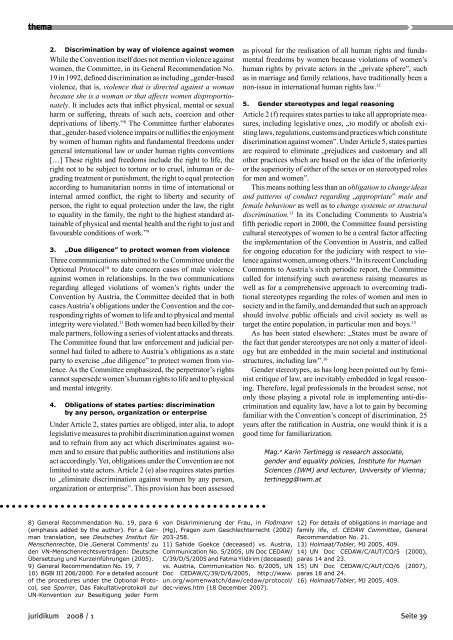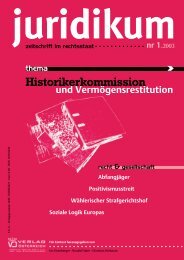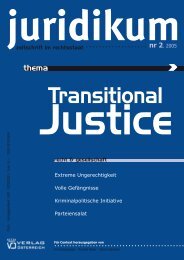Download - juridikum, zeitschrift für kritik | recht | gesellschaft
Download - juridikum, zeitschrift für kritik | recht | gesellschaft
Download - juridikum, zeitschrift für kritik | recht | gesellschaft
Sie wollen auch ein ePaper? Erhöhen Sie die Reichweite Ihrer Titel.
YUMPU macht aus Druck-PDFs automatisch weboptimierte ePaper, die Google liebt.
thema<br />
2. Discrimination by way of violence against women<br />
While the Convention itself does not mention violence against<br />
women, the Committee, in its General Recommendation No.<br />
19 in 1992, defined discrimination as including „gender-based<br />
violence, that is, violence that is directed against a woman<br />
because she is a woman or that affects women disproportionately.<br />
It includes acts that inflict physical, mental or sexual<br />
harm or suffering, threats of such acts, coercion and other<br />
deprivations of liberty.” 8 The Committee further elaborates<br />
that „gender-based violence impairs or nullifies the enjoyment<br />
by women of human rights and fundamental freedoms under<br />
general international law or under human rights conventions<br />
[…] These rights and freedoms include the right to life, the<br />
right not to be subject to torture or to cruel, inhuman or degrading<br />
treatment or punishment, the right to equal protection<br />
according to humanitarian norms in time of international or<br />
internal armed conflict, the right to liberty and security of<br />
person, the right to equal protection under the law, the right<br />
to equality in the family, the right to the highest standard attainable<br />
of physical and mental health and the right to just and<br />
favourable conditions of work.” 9<br />
3. „Due diligence” to protect women from violence<br />
Three communications submitted to the Committee under the<br />
Optional Protocol 10 to date concern cases of male violence<br />
against women in relationships. In the two communications<br />
regarding alleged violations of women’s rights under the<br />
Convention by Austria, the Committee decided that in both<br />
cases Austria’s obligations under the Convention and the corresponding<br />
rights of women to life and to physical and mental<br />
integrity were violated. 11 Both women had been killed by their<br />
male partners, following a series of violent attacks and threats.<br />
The Committee found that law enforcement and judicial personnel<br />
had failed to adhere to Austria’s obligations as a state<br />
party to exercise „due diligence” to protect women from violence.<br />
As the Committee emphasized, the perpetrator’s rights<br />
cannot supersede women’s human rights to life and to physical<br />
and mental integrity.<br />
4. Obligations of states parties: discrimination<br />
by any person, organization or enterprise<br />
Under Article 2, states parties are obliged, inter alia, to adopt<br />
legislative measures to prohibit discrimination against women<br />
and to refrain from any act which discriminates against women<br />
and to ensure that public authorities and institutions also<br />
act accordingly. Yet, obligations under the Convention are not<br />
limited to state actors. Article 2 (e) also requires states parties<br />
to „eliminate discrimination against women by any person,<br />
organization or enterprise”. This provision has been assessed<br />
as pivotal for the realisation of all human rights and fundamental<br />
freedoms by women because violations of women’s<br />
human rights by private actors in the „private sphere”, such<br />
as in marriage and family relations, have traditionally been a<br />
non-issue in international human rights law. 12<br />
5. Gender stereotypes and legal reasoning<br />
Article 2 (f) requires states parties to take all appropriate measures,<br />
including legislative ones, „to modify or abolish existing<br />
laws, regulations, customs and practices which constitute<br />
discrimination against women”. Under Article 5, states parties<br />
are required to eliminate „prejudices and customary and all<br />
other practices which are based on the idea of the inferiority<br />
or the superiority of either of the sexes or on stereotyped roles<br />
for men and women”.<br />
This means nothing less than an obligation to change ideas<br />
and patterns of conduct regarding „appropriate” male and<br />
female behaviour as well as to change systemic or structural<br />
discrimination. 13 In its Concluding Comments to Austria’s<br />
fifth periodic report in 2000, the Committee found persisting<br />
cultural stereotypes of women to be a central factor affecting<br />
the implementation of the Convention in Austria, and called<br />
for ongoing education for the judiciary with respect to violence<br />
against women, among others. 14 In its recent Concluding<br />
Comments to Austria’s sixth periodic report, the Committee<br />
called for intensifying such awareness raising measures as<br />
well as for a comprehensive approach to overcoming traditional<br />
stereotypes regarding the roles of women and men in<br />
society and in the family, and demanded that such an approach<br />
should involve public officials and civil society as well as<br />
target the entire population, in particular men and boys. 15<br />
As has been stated elsewhere: „States must be aware of<br />
the fact that gender stereotypes are not only a matter of ideology<br />
but are embedded in the main societal and institutional<br />
structures, including law”. 16<br />
Gender stereotypes, as has long been pointed out by feminist<br />
critique of law, are inevitably embedded in legal reasoning.<br />
Therefore, legal professionals in the broadest sense, not<br />
only those playing a pivotal role in implementing anti-discrimination<br />
and equality law, have a lot to gain by becoming<br />
familiar with the Convention’s concept of discrimination. 25<br />
years after the ratification in Austria, one would think it is a<br />
good time for familiarization.<br />
Mag. a Karin Tertinegg is research associate,<br />
gender and equality policies, Institute for Human<br />
Sciences (IWM) and lecturer, University of Vienna;<br />
tertinegg@iwm.at<br />
8) General Recommendation No. 19, para 6<br />
(emphasis added by the author). For a German<br />
translation, see Deutsches Institut für<br />
Menschen<strong>recht</strong>e, Die ‚General Comments’ zu<br />
den VN-Menschen<strong>recht</strong>sverträgen: Deutsche<br />
Übersetzung und Kurzeinführungen (2005).<br />
9) General Recommendation No. 19, 7<br />
10) BGBl III 206/2000. For a detailed account<br />
of the procedures under the Optional Protocol,<br />
see Sporrer, Das Fakultativprotokoll zur<br />
UN-Konvention zur Beseitigung jeder Form<br />
von Diskriminierung der Frau, in Floßmann<br />
(Hg), Fragen zum Geschlechter<strong>recht</strong> (2002)<br />
203-258.<br />
11) Sahide Goekce (deceased) vs. Austria,<br />
Communication No. 5/2005, UN Doc CEDAW/<br />
C/39/D/5/2005 and Fatma Yildirim (deceased)<br />
vs. Austria, Communication No. 6/2005, UN<br />
Doc CEDAW/C/39/D/6/2005, http://www.<br />
un.org/womenwatch/daw/cedaw/protocol/<br />
dec-views.htm (18 December 2007).<br />
12) For details of obligations in marriage and<br />
family life, cf. CEDAW Committee, General<br />
Recommendation No. 21.<br />
13) Holmaat/Tobler, MJ 2005, 409.<br />
14) UN Doc CEDAW/C/AUT/CO/5 (2000),<br />
paras 14 and 23.<br />
15) UN Doc CEDAW/C/AUT/CO/6 (2007),<br />
paras 18 and 24.<br />
16) Holmaat/Tobler, MJ 2005, 409.<br />
<strong>juridikum</strong> 2008 / 1 Seite 39
















